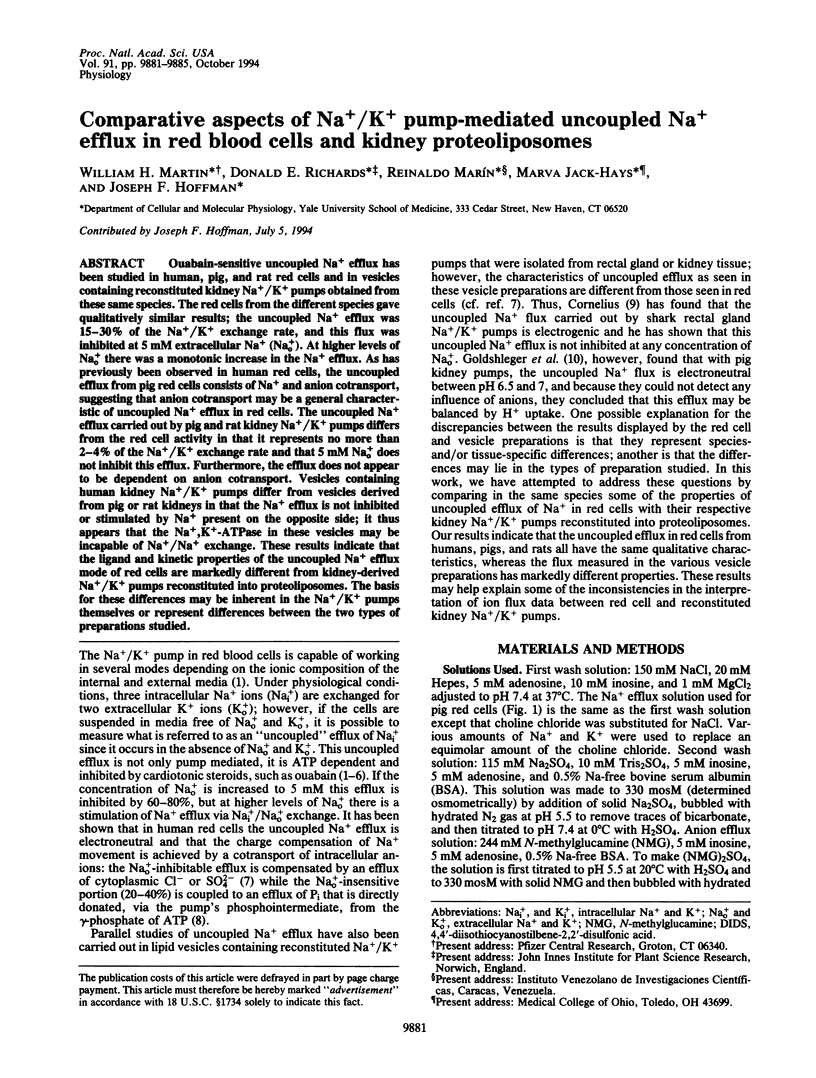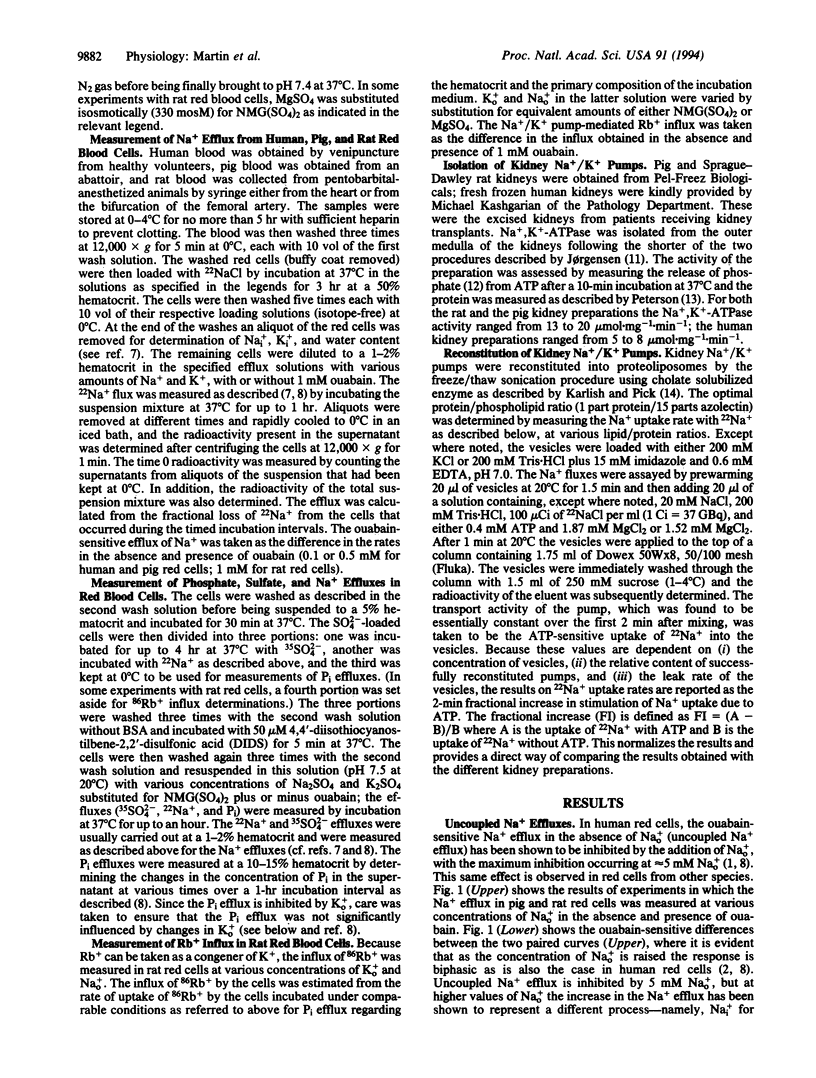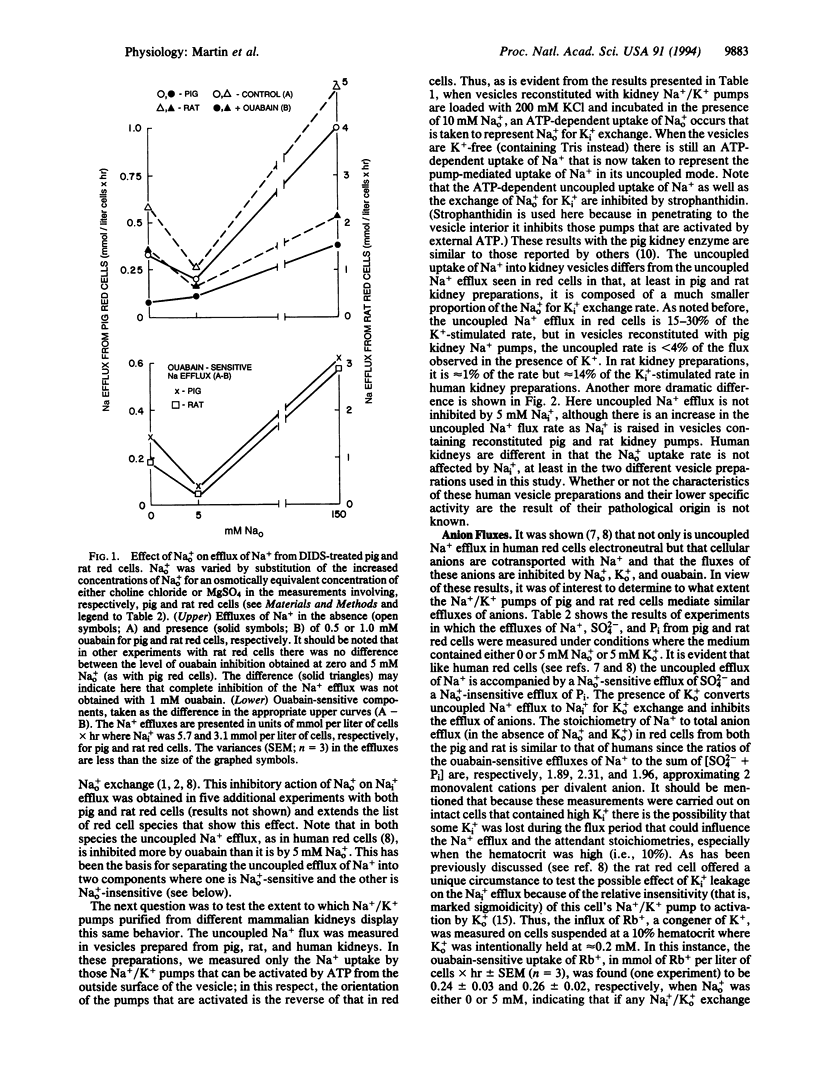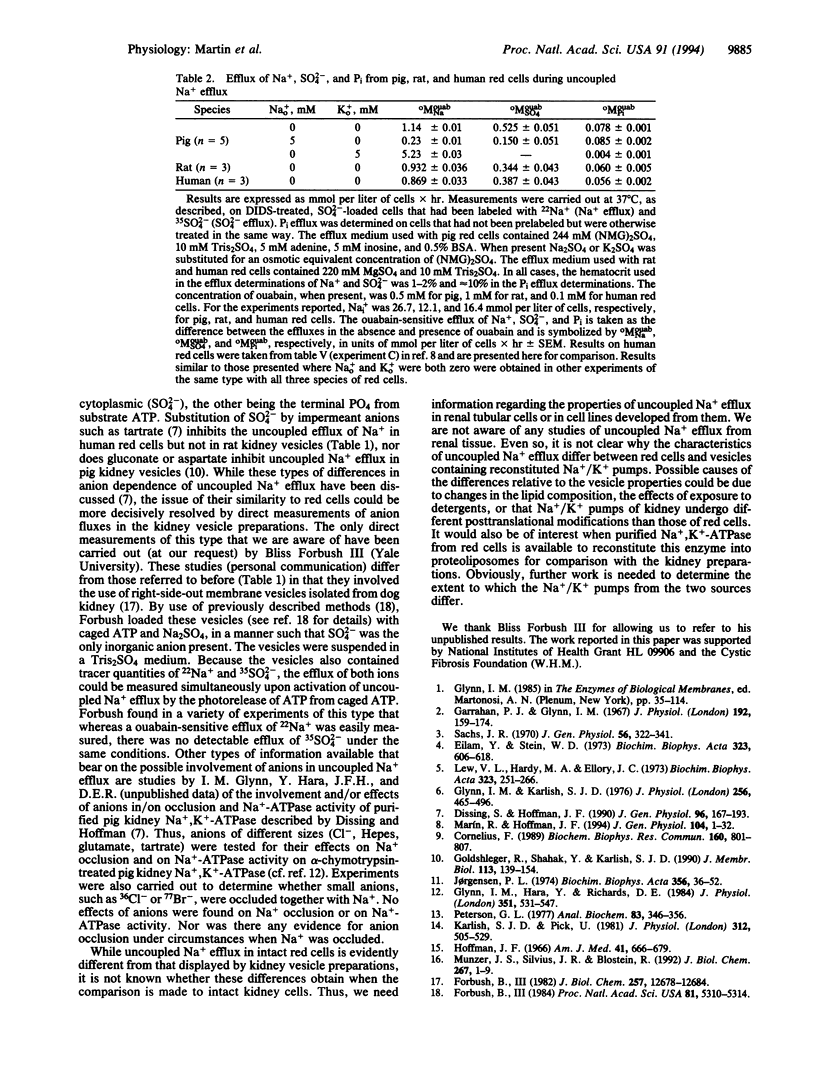Abstract
Ouabain-sensitive uncoupled Na+ efflux has been studied in human, pig, and rat red cells and in vesicles containing reconstituted kidney Na+/K+ pumps obtained from these same species. The red cells from the different species gave qualitatively similar results; the uncoupled Na+ efflux was 15-30% of the Na+/K+ exchange rate, and this flux was inhibited at 5 mM extracellular Na+ (Na+o). At higher levels of Na+o there was a monotonic increase in the Na+ efflux. As has previously been observed in human red cells, the uncoupled efflux from pig red cells consists of Na+ and anion cotransport, suggesting that anion cotransport may be a general characteristic of uncoupled Na+ efflux in red cells. The uncoupled Na+ efflux carried out by pig and rat kidney Na+/K+ pumps differs from the red cell activity in that it represents no more than 2-4% of the Na+/K+ exchange rate and that 5 mM Na+o does not inhibit this efflux. Furthermore, the efflux does not appear to be dependent on anion cotransport. Vesicles containing human kidney Na+/K+ pumps differ from vesicles derived from pig or rat kidneys in that the Na+ efflux is not inhibited or stimulated by Na+ present on the opposite side; it thus appears that the Na+,K(+)-ATPase in these vesicles may be incapable of Na+/Na+ exchange. These results indicate that the ligand and kinetic properties of the uncoupled Na+ efflux mode of red cells are markedly different from kidney-derived Na+/K+ pumps reconstituted into proteoliposomes. The basis for these differences may be inherent in the Na+/K+ pumps themselves or represent differences between the two types of preparations studied.
Full text
PDF




Selected References
These references are in PubMed. This may not be the complete list of references from this article.
- Cornelius F. Uncoupled Na+-efflux on reconstituted shark Na,K-ATPase is electrogenic. Biochem Biophys Res Commun. 1989 Apr 28;160(2):801–807. doi: 10.1016/0006-291x(89)92504-7. [DOI] [PubMed] [Google Scholar]
- Dissing S., Hoffman J. F. Anion-coupled Na efflux mediated by the human red blood cell Na/K pump. J Gen Physiol. 1990 Jul;96(1):167–193. doi: 10.1085/jgp.96.1.167. [DOI] [PMC free article] [PubMed] [Google Scholar]
- Eilam Y., Stein W. D. The efflux of sodium from human red blood cells. Biochim Biophys Acta. 1973 Nov 16;323(4):606–619. doi: 10.1016/0005-2736(73)90169-7. [DOI] [PubMed] [Google Scholar]
- Forbush B., 3rd Characterization of right-side-out membrane vesicles rich in (Na,K)-ATPase and isolated from dog kidney outer medulla. J Biol Chem. 1982 Nov 10;257(21):12678–12684. [PubMed] [Google Scholar]
- Forbush B., 3rd Na+ movement in a single turnover of the Na pump. Proc Natl Acad Sci U S A. 1984 Sep;81(17):5310–5314. doi: 10.1073/pnas.81.17.5310. [DOI] [PMC free article] [PubMed] [Google Scholar]
- Garrahan P. J., Glynn I. M. The behaviour of the sodium pump in red cells in the absence of external potassium. J Physiol. 1967 Sep;192(1):159–174. doi: 10.1113/jphysiol.1967.sp008294. [DOI] [PMC free article] [PubMed] [Google Scholar]
- Glynn I. M., Hara Y., Richards D. E. The occlusion of sodium ions within the mammalian sodium-potassium pump: its role in sodium transport. J Physiol. 1984 Jun;351:531–547. doi: 10.1113/jphysiol.1984.sp015261. [DOI] [PMC free article] [PubMed] [Google Scholar]
- Glynn I. M., Karlish S. J. ATP hydrolysis associated with an uncoupled sodium flux through the sodium pump: evidence for allosteric effects of intracellular ATP and extracellular sodium. J Physiol. 1976 Apr;256(2):465–496. doi: 10.1113/jphysiol.1976.sp011333. [DOI] [PMC free article] [PubMed] [Google Scholar]
- Goldshleger R., Shahak Y., Karlish S. J. Electrogenic and electroneutral transport modes of renal Na/K ATPase reconstituted into proteoliposomes. J Membr Biol. 1990 Feb;113(2):139–154. doi: 10.1007/BF01872888. [DOI] [PubMed] [Google Scholar]
- Hoffman J. F. The red cell membrane and the transport of sodium and potassium. Am J Med. 1966 Nov;41(5):666–680. doi: 10.1016/0002-9343(66)90029-5. [DOI] [PubMed] [Google Scholar]
- Jorgensen P. L. Purification and characterization of (Na+ plus K+ )-ATPase. 3. Purification from the outer medulla of mammalian kidney after selective removal of membrane components by sodium dodecylsulphate. Biochim Biophys Acta. 1974 Jul 12;356(1):36–52. doi: 10.1016/0005-2736(74)90292-2. [DOI] [PubMed] [Google Scholar]
- Karlish S. J., Pick U. Sidedness of the effects of sodium and potassium ions on the conformational state of the sodium-potassium pump. J Physiol. 1981 Mar;312:505–529. doi: 10.1113/jphysiol.1981.sp013641. [DOI] [PMC free article] [PubMed] [Google Scholar]
- Khorana H. G. Rhodopsin, photoreceptor of the rod cell. An emerging pattern for structure and function. J Biol Chem. 1992 Jan 5;267(1):1–4. [PubMed] [Google Scholar]
- Lew V. L., Hardy M. A., Jr, Ellory J. C. The uncoupled extrusion of Na+ through the Na+ pump. Biochim Biophys Acta. 1973 Oct 11;323(2):251–266. doi: 10.1016/0005-2736(73)90149-1. [DOI] [PubMed] [Google Scholar]
- Marín R., Hoffman J. F. Phosphate from the phosphointermediate (EP) of the human red blood cell Na/K pump is coeffluxed with Na, in the absence of external K. J Gen Physiol. 1994 Jul;104(1):1–32. doi: 10.1085/jgp.104.1.1. [DOI] [PMC free article] [PubMed] [Google Scholar]
- Peterson G. L. A simplification of the protein assay method of Lowry et al. which is more generally applicable. Anal Biochem. 1977 Dec;83(2):346–356. doi: 10.1016/0003-2697(77)90043-4. [DOI] [PubMed] [Google Scholar]
- Sachs J. R. Sodium movements in the human red blood cell. J Gen Physiol. 1970 Sep;56(3):322–341. doi: 10.1085/jgp.56.3.322. [DOI] [PMC free article] [PubMed] [Google Scholar]


